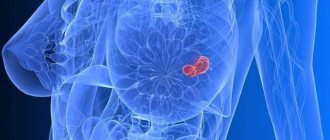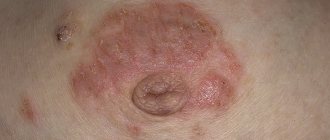Breast fibrolipoma is a tumor of benign origin, which includes both fibrous and adipose tissue. Women who have crossed the age of forty are at greatest risk of developing this pathology. This tumor causes almost no pain, and therefore it is not possible to detect the problem immediately. If left untreated, fibrolipoma, in some cases, can develop into a malignant form, so timely diagnosis is the most important method of preventing dangerous consequences.
Causes
The reasons for the development of fibrolipoma have not been precisely established. Some researchers believe that the neoplasm occurs as a result of embryogenesis disorders (intrauterine formation of atypical adipose tissue cells in the mammary gland). Other scientists believe that the main factor in the development of the disease is systemic metabolic disorders. In addition, experts focus on the possible connection between breast fibroids and changes in hormonal levels - this connection is supported by the frequent manifestation of the disease during the period of hormonal changes in the body (during menopause or premenopause). Other factors contributing to the development of fibrolipoma include diseases of the pituitary gland, thyroid gland, liver and pancreas. There are suggestions that the risk of breast fibrolipoma increases with alcoholism, diabetes, living in unfavorable environmental conditions and prolonged psycho-emotional stress. In some cases, a hereditary predisposition is revealed.
Lipoma in the breast: causes
Why lipoma develops in the mammary glands is still not known. It is assumed that the formation of a lipoma occurs when the duct of the sebaceous gland is blocked. It is believed that there are a number of factors that contribute to the formation of lipoma:
- Hormonal imbalance. Often, breast lipoma forms in women after 45 years of age during the premenopausal period, during hormonal changes.
- Hereditary predisposition. Breast lipomas form due to a defect in the HMG IC gene and certain chromosomal regions. In this case, multiple lipomas are formed.
- Exogenous cause. The development of lipoma can be affected by negative effects on the mammary gland - trauma, burns, hypothermia, constant wearing of uncomfortable underwear, plastic surgery.
- Metabolic disease. Low-density lipoproteins accumulate in breast tissue due to the inability to completely penetrate the vascular endothelium. Dense fats accumulate and turn into lipoma. This condition of adipose tissue develops with physical inactivity, defects in enzyme structures and with high consumption of animal fats and meat.
Breast lipoma can form in men, but much less frequently than in women. The causes of lipoma in men are hormonal imbalance, metabolic disorders, hereditary predisposition, trauma and other reasons.
Symptoms
Symptoms of breast fibrolipoma are not pronounced, so palpation and self-examination of the breast does not always reveal pathology. But if the tumor grows, it leads to deformation of the gland and the symptoms of the tumor are visible to the naked eye. As a rule, fibrolipoma develops in the deep layers of tissue, but sometimes skin changes are visible on the surface of the breast, that is, cosmetic defects of the disease. Fibrolipoma is a pathology that is characterized by a long course and the transformation of healthy tissue into fibrin fibers of connective tissue. There is a high risk of deposition of calcium salts in the tumor tissue. In this case, the tumor causes pain and discomfort when wearing a bra. If such symptoms occur, the fibrolipoma must be removed, since other types of tumor formations may arise against its background. If blood vessels grow into the tumor, this leads to its transformation into an angiolipoma, surgical treatment of which is accompanied by severe bleeding.
Breast lipoma: symptoms and types
Signs of a breast lipoma are the appearance of a round, elastic and painless formation. The formation is detected by chance when the lipoma reaches a size of 1-2 centimeters. A large lipoma causes discomfort, pain when it grows into the pectoral muscle, into the fascia, and leads to the formation of a cosmetic defect. Lipoma can be a manifestation of a hereditary disease - lipomatosis. In this case, lipomas form throughout the patient’s body; when one lipoma is removed, other formations begin to develop. When examining a lipoma, its type is determined by the ratio of vascular, fibrous, muscle and fatty components of the formation. Classification of breast lipoma:
- Classic lipoma consists of adipocytes (fat cells).
- Fibrolipomas consist of fat cells and connective tissue components, a denser formation among lipomas.
- Lipofibroma consists of connective tissue and fat cells.
- Myxolipomas are composed of fat cells and mucus.
- Angiolipomas consist of fat cells and a large number of blood vessels.
- Myolipomas contain smooth muscle fibers and adipose tissue.
The most rare types of myolipomas and myolipomas are found in the mammary glands. The most common are fibrolipomas and classic lipomas. Lipomas located deep in the mammary gland are detected during mammography or ultrasound.
Diagnostics
In order to correctly make a diagnosis, it is often enough to carefully examine and palpate the patient’s mammary glands (a local compaction with clear contours can be felt, which can be mobile). Women, as a rule, do not complain; they are more concerned about the aesthetic defect (especially if the fibrolipoma reaches a large size). Additional research methods include ultrasound and mammography (breast x-ray). During ultrasound examination, fibrolipoma has the appearance of adipose tissue with low echogenicity and a heterogeneous structure.
Symptoms of fibroadenoma
You can recognize breast fibroadenoma on your own; sometimes women turn to a mammologist with complaints of pain and tightness in the breast. The node appears against the background of mastopathy and is one of its varieties. Therefore, the following symptoms are common:
- engorgement of the mammary glands in the second half of the menstrual cycle;
- breast tenderness;
- dense nodes in the thickness of the gland;
- discharge from the nipples of different colors and consistency.
To notice fibroadenoma at an early stage, it is necessary to conduct a self-examination according to a special scheme every month after the end of menstruation. But small nodes cannot always be palpated; even doctors with many years of experience may not notice a tumor several millimeters in size. Therefore, women at risk are recommended to undergo an ultrasound of the mammary glands annually.
Treatment
Removal is carried out when the pathology grows rapidly and when the fibrolipoma reaches large sizes, causing cosmetic defects and compression of the gland tissue. Surgery is necessary if there is a risk of tumor malignancy. A high risk of degeneration into cancer occurs in the premenopausal period. If the size of the formation is no more than 2-3 cm, then medications are administered for resorption. The course of treatment takes about a month with breaks. If the formation is small and does not cause inconvenience, the fibrolipoma can be left. But in this case, careful medical supervision is required. Every quarter, a woman should undergo an ultrasound examination, mammography and tests for tumor markers several times a year. Oncocytology of nipple discharge is mandatory. After surgical treatment, the patient will undergo a course of rehabilitation. To fully restore the body and prevent relapses of fibrolipoma, the woman is prescribed immunomodulatory and vitamin preparations. Regular examination of the mammary glands is mandatory. After the operation, it is necessary to undergo examination by a mammologist 3-4 times a year and conduct an ultrasound examination to timely identify new foci of pathology.
Breast fibroadenoma: how can a doctor help?
A breast tumor is a frightening diagnosis, but it should be remembered that the capabilities of modern medicine make it possible to recognize and treat such pathologies. One of them is fibroadenoma. What is she like? To whom and why does it appear? How to find it? With these and other questions, we turned to the doctor - oncologist-mammologist "Clinic Expert" Tula Timur Arifovich Guseinov.
- Timur Arifovich, fibroadenoma of the mammary glands - what is it?
This is a benign neoplasm of soft tissue of the mammary glands, consisting of connective and glandular tissue. Most often, the tumor is surrounded by a connective tissue membrane and filled with glandular tissue.
— For what reasons can fibroadenoma of the mammary glands appear?
Unfortunately, there is no clear answer to this question, since the true cause of the development of fibroadenoma is not clear at the moment. It is assumed that fibroadenoma can form as a result of impaired development of mammary gland tissue and hormonal imbalance.
— How common is this pathology? Are there risk groups?
Fibroadenoma occurs in 3-10% of cases of all breast diseases. Women aged 25-40 years are at risk.
— By what signs can a woman suspect breast fibroadenoma?
Discomfort in one or both mammary glands, a sensation of a dense, moving, spherical lump located under the skin or in the thickness of the breast tissue - all these are possible symptoms of fibroadenoma. In addition, if this tumor is present, women may experience pain when wearing tight underwear.
— Tell us about the types of breast fibroadenoma.
Depending on which cells form the fibroadenoma, connective tissue, glandular and mixed forms of the tumor are distinguished.
I would like to dwell in more detail on leaf-shaped (otherwise, phylloid) fibroadenoma. This is a fairly rare hormone-dependent type of fibroadenoma, which is characterized by rapid progressive growth. This is especially noticeable in pregnant women, when a hormonal surge causes the tumor to increase several dozen times in a short period of time (several days or weeks). Therefore, women during pregnancy should be more attentive to the condition of the mammary glands. If small fibroadenomas are detected, you should consult with a mammologist about their removal during pregnancy planning.
— How is breast fibroadenoma diagnosed?
The neoplasm is usually discovered by the patient herself, or during routine follow-up. To make a diagnosis, ultrasound of the mammary gland, mammography, MRI of the mammary glands and puncture biopsy are performed, followed by histological examination.
Read materials on the topic:
What does an ultrasound of the mammary glands show? Mammography: an important test for women Histology: what kind of analysis is it?
— How to treat breast fibroadenoma? Does it always need to be operated on or are there alternative methods of treating this pathology?
Certain principles have been developed in the treatment of fibroadenoma. If the tumor is stable, does not grow, and its size does not exceed 1 cm, it is monitored over time. If the tumor progressively increases in size, has unclear contours and increased blood flow, surgical intervention is recommended - removal of the fibroadenoma with a certain volume of healthy breast tissue. Breast resection is performed from a cosmetic approach, that is, the woman will not see the scar after the operation.
An alternative method for treating breast fibroadenomas without surgery is vacuum aspiration biopsy. In this case, the formation in the mammary gland is removed under ultrasound control using a special device. Then it is sent for histological examination to exclude malignant pathology. The undoubted advantages of this method are the absence of incisions and the possibility of performing the intervention on an outpatient basis.
— Can breast fibroadenoma resolve on its own?
Yes it is possible. Such cases are described in the literature. When conservative treatment is prescribed, when the hormonal levels in a woman’s body are normalized, small fibroadenomas (less than 1 cm) can resolve on their own.
— Is it possible for breast fibroadenoma to transform into a malignant tumor?
No. True fibroadenomas do not become malignant. The erroneous opinion that fibroadenoma can degenerate into a malignant neoplasm is associated with the peculiarity of some small primary malignant tumors to “masquerade” as fibroadenomas.
— Is it possible to get pregnant with breast fibroadenoma? If so, what should you pay attention to?
Carrying a pregnancy to term with fibroadenomas is not contraindicated. But if there is a suspicion of a leaf-shaped form of breast fibroadenoma, then getting pregnant before the tumor is removed is not recommended.
— Are relapses possible after removal of mammary fibroadenoma? How to prevent their development?
Yes, relapses are possible if the fibroadenoma is not completely removed - for example, part of the capsule is preserved. There is another option, when multiple locations of fibroadenomas are observed, and a neoplasm may reappear near the site of tumor removal. In this case, we are not talking about a relapse.
High-quality diagnosis and competently performed surgery can prevent the development of relapses.
You can make an appointment with a mammologist here. ATTENTION: the service is not available in all cities
Interviewed by Sevilya Ibraimova
The editors recommend:
Is mastopathy dangerous? Let's not panic, but heal! Breast cancer is not a death sentence!
For reference:
Guseinov Timur Arifovich
In 2009 he graduated from the Medical Institute of Tula State University.
In 2010, he completed an internship in surgery, and in 2011, in oncology.
Repeatedly completed advanced training in mammology.
Currently holds the position of oncologist-mammologist at the Expert Clinic in Tula. Receives at the address: st. Boldina, 74.









